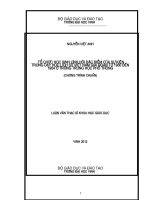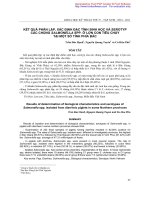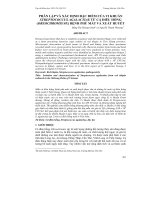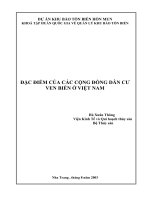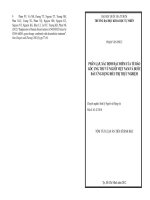Phân lập, xác định đặc điểm của tế bào gốc ung thư vú người việt nam và bước đầu ứng dụng điều trị thực nghiệm
Bạn đang xem bản rút gọn của tài liệu. Xem và tải ngay bản đầy đủ của tài liệu tại đây (7.06 MB, 173 trang )
VIETNAM NATIONAL UNIVERSITY – HO CHI MINH CITY
UNIVERSITY OF SCIENCE
PHAM VAN PHUC
ISOLATION, CHARACTERISATION OF VIETNAMESE BREAST
CANCER STEM CELLS AND INITIAL EXPERIMENTAL
RESEARCH ON BREAST CANCER TREATMENT
DOCTORAL THESIS: BIOLOGY
HO CHI MINH CITY – 2012
VIETNAM NATIONAL UNIVERSITY – HO CHI MINH CITY
UNIVERSITY OF SCIENCE
PHAM VAN PHUC
ISOLATION, CHARACTERISATION OF VIETNAMESE BREAST
CANCER STEM CELLS AND INITIAL EXPERIMENTAL
RESEARCH ON BREAST CANCER TREATMENT
Specialty: Animal and Human Physiology
Code: 62 42 30 01
Reviewer 1
Tran Linh Thuoc, Professor, PhD
Reviewer 2
Nguyen Sao Trung, Professor, PhD
Reviewer 3
Huynh Nghia, PhD
Independent reviewer 1
Tran Cat Dong, Associate Professor,
PhD
Independent reviewer 2
Nguyen Dang Quan, PhD
SUPERVISORS:
1. Truong Dinh Kiet, Professor, PhD.
2. Le Van Dong, PhD., MD.
Ho Chi Minh City – 2012
2
ĐẠI HỌC QUỐC GIA TP.HCM
TRƯỜNG ĐẠI HỌC KHOA HỌC TỰ NHIÊN
PHẠM VĂN PHÚC
PHÂN LẬP, XÁC ĐỊNH ĐẶC ĐIỂM CỦA TẾ BÀO GỐC UNG THƯ
VÚ NGƯỜI VIỆT NAM VÀ BƯỚC ĐẦU ỨNG DỤNG ĐIỀU TRỊ
THỰC NGHIỆM
LUẬN ÁN TIẾN SĨ: SINH HỌC
TP. HỒ CHÍ MINH – 2012
3
ĐẠI HỌC QUỐC GIA TP.HCM
TRƯỜNG ĐẠI HỌC KHOA HỌC TỰ NHIÊN
PHẠM VĂN PHÚC
PHÂN LẬP, XÁC ĐỊNH ĐẶC ĐIỂM CỦA TẾ BÀO GỐC UNG THƯ
VÚ NGƯỜI VIỆT NAM VÀ BƯỚC ĐẦU ỨNG DỤNG ĐIỀU TRỊ
THỰC NGHIỆM
Chuyên ngành: Sinh lý Người và Động vật
Mã số: 62 42 30 01
Phản biện 1
GS.TS. Trần Linh Thước
Phản biện 2
GS.TS. Nguyễn Sào Trung
Phản biện 3
TS. Huỳnh Nghĩa
Phản biện độc lập 1
PGS.TS. Trần Cát Đông
Phản biện độc lập 2
TS. Nguyễn Đăng Quân
Cán bộ hướng dẫn:
1. GS.TS. Trương Đình Kiệt
2. TS.BS. Lê Văn Đơng
TP. Hồ Chí Minh – 2012
4
DECLARATION
I, the undersigned, hereby declare that this research thesis is my own original work
and that all sources have been accurately reported and acknowledged and that this
document has not been previously, in its entirety or in part, submitted at any
university in order to achieve educational qualifications. Where other sources of
information have been used, they have been acknowledged.
The work was done under the guidance of Professor Truong Dinh Kiet and
Doctor Le Van Dong, at the Laboratory of Stem Cell Research and Application,
University of Science, Vietnam National University, Ho Chi Minh city, Vietnam.
HCM city, 9/9/2012
Pham Van Phuc
5
ACKNOWLEDGMENTS
The research could not have been completed without the significant contributions
made by Professor, Doctor Truong Dinh Kiet and Doctor Le Van Dong. I thank my
teacher - Phan Kim Ngoc for his help and support in and out of the laboratory.
I also thank all members of my Laboratory of Stem Cell Research and Application,
Department of Animal Physiology and Biotechnology for their continuous support
and feedback throughout the progress of this project.
I extend my appreciation to all members of the Oncology Hospital, Hung Vuong
Hospital, Department of Anatomic Pathology, Ho Chi Minh City Medicine and
Pharmacy University for their support in supplying breast tumors and umbilical
cord blood and in analyzing the tumor histochemistry, respectively.
6
TABLE OF CONTENTS
TABLE OF CONTENTS............................................................................................ i
LIST OF ABBREVIATIONS .................................................................................. vi
LIST OF TABLES .................................................................................................... ix
LIST OF FIGURES ................................................................................................... x
INTRODUCTION ...................................................................................................... 1
Chapter 1: LITERATURE REVIEW
1.1. STEM CELLS AND CANCER STEM CELLS .............................................. 3
1.1.1. Stem cells ....................................................................................................... 3
1.1.2. Cancer stem cells .......................................................................................... 4
1.1.2.1. Tumor contains cancer cells with SC properties .................................... 4
1.1.2.2. Cancer stem cell hypothesis .................................................................... 6
1.2. BREAST CANCER AND BREAST CANCER STEM CELLS .................... 8
1.2.1. Breast cancer................................................................................................. 8
1.2.2. Breast cancer stem cells ............................................................................... 9
1.2.2.1. Markers, identification and isolation ...................................................... 9
1.2.2.2. Important characteristics of BCSCs ...................................................... 12
1.3. BREAST CANCER STEM CELLS TARGETING THERAPY ................. 15
1.3.1. Targeting on stemness of BCSCs.............................................................. 15
1.3.1.1. Directly targeting on BCSC self-renewal ............................................. 15
1.3.1.2. Indirectly targeting on BCSC microenvironment ................................. 17
1.3.2. Killing BCSCs by specific markers .......................................................... 17
1.3.2.1. Chemotherapy causes differentiation or apoptosis of BCSCs ............. 17
1.3.2.2. Immune cell based immunotherapy ...................................................... 18
1.3.2.3. Oncolytic virus ...................................................................................... 18
1.4. KNOCK DOWN GENE THERAPY AND IMMUNOTHERAPY ............. 19
1.4.1. Knock down gene therapy for cancer ...................................................... 19
1.4.1.1. General introduction .............................................................................. 19
1.4.1.2. Non-viral vector vs viral vector ............................................................ 21
1.4.1.3. siRNA strategies in cancer treatment .................................................... 22
i
1.4.2. Immunotherapy for cancer by dendritic cells......................................... 24
1.4.2.1. Immunotherapy...................................................................................... 24
1.4.2.2. Immunotherapy for cancer .................................................................... 24
1.4.2.3. Dendritic cells based immunotherapy ................................................... 25
1.4.2.4. Breast treatment by dendritic cell therapy ............................................ 26
Chapter 2: MATERIALS - METHODS
2.1. MATERIALS..................................................................................................... 29
2.1.1. Instruments ................................................................................................. 29
2.1.2. Chemicals and Consumables .................................................................... 30
2.1.3. Solutions, cell culture medium, growth factors and antibodies ............ 30
2.1.4. Kits ............................................................................................................... 32
2.1.5. Biological samples ...................................................................................... 32
2.2. METHODS ........................................................................................................ 33
2.2.1. Cell culture .................................................................................................. 33
2.2.1.1. Primary cell culture ............................................................................... 33
2.2.1.2. Sub-culture ............................................................................................. 34
2.2.1.3. Sphere formation culture ....................................................................... 34
2.2.2. GFP transgenesis and establishment of GFP expressing cells .............. 34
2.2.3. Cell sorting .................................................................................................. 35
2.2.4. Immunophenotype analysis by flow cytometry ...................................... 36
2.2.5. Immunophenotype analysis by immunocytochemistry ......................... 37
2.2.6. Knock-down of CD44 on BCSCs .............................................................. 37
2.2.6.1. CD44 down regulation by siRNA ......................................................... 37
2.2.6.2. CD44 down regulation by shRNA ........................................................ 38
2.2.7. Gene expression analysis ........................................................................... 38
2.2.7.1. RNA total isolation ................................................................................ 38
2.2.7.2. RT-PCR ................................................................................................. 39
2.2.7.3. Real-time RT PCR................................................................................. 39
2.2.7.4. GeXP PCR ............................................................................................. 39
2.2.8. Cell bioassays .............................................................................................. 44
2.2.8.1. Anti-tumor drug resistant assay ............................................................ 44
ii
2.2.8.2. Apoptosis and cell cycle analysis.......................................................... 44
2.2.8.3. Cell proliferation assay .......................................................................... 44
2.2.9. In vivo tumorigenesis assay ....................................................................... 44
2.2.10. Experimental treatment of breast cancer by knowdown of CD44 ..... 45
2.2.11. Cell culture and differentiation of monocytes into dendritic cells ..... 46
2.2.12. Dendritic cell characterization................................................................ 47
2.2.12.1. Dextran-FITC uptake assay................................................................. 47
2.2.12.2. Stimulation of CD4 + T lymphocyte proliferation ............................... 47
2.2.12.3. Quantity of production of cytokines/chemokines ............................... 47
2.2.13. Experiment treatment of breast cancer by dendritic cells primed with
BCSC extract therapy .......................................................................................... 48
2.2.13.1. Animals models ................................................................................... 48
2.2.13.2. BCSC antigen production.................................................................... 48
2.2.13.3. DCs primed with BCSC extract .......................................................... 48
2.2.13.4. Mice treatment schedule...................................................................... 49
2.2.14. Mycoplasma detection ............................................................................. 49
2.2.15. Statistical analysis .................................................................................... 50
Chapter 3: RESULTS
3.1. ISOLATION OF BREAST CANCER CELL LINE VNBRC1 AND
VNBRC2 .................................................................................................................... 51
3.1.1. Primary cell culture ................................................................................... 51
3.1.2. Isolation of breast cancer cell candidates ................................................ 52
3.1.3. Characterization of breast cancer cell candidates.................................. 54
3.1.3.1. Purity of breast cancer cell candidates ......................... 54_Toc343253993
3.1.3.2. Gene expression characteristics of VNBRC ......................................... 55
3.1.3.3. In vivo tumor formation ......................................................................... 56
3.1.3.4. Mycoplasma contamination .................................................................. 57
3.2. ISOLATION OF BREAST CANCER STEM CELL LINE BCSC1 AND
BCSC2........................................................................................................................ 58
3.2.1. Existence of BCSC sub-population in primary cells .............................. 58
3.2.2. Characteristics of BCSC............................................................................ 59
iii
3.2.2.1. Expression of BCSC markers CD44+CD24-......................................... 59
3.2.2.2. In vitro self renewal ............................................................................... 60
3.2.2.3. In vivo tumor formation at low dose of BCSC and the tumors are
caused by injected BCSC ................................................................................... 61
3.2.2.4. BCSC population is resistant with anti-cancer drugs ........................... 62
3.2.2.5. Mycoplasma contamination .................................................................. 63
3.2.2.6. BCSCs maintained the phenotype after proliferating ........................... 63
3.3. CD44 KNOCK DOWN GENE THERAPY ................................................... 64
3.3.1. CD44 down regulation and anti-doxorubicin resistance of BCSCs ......... 64
3.3.1.1. Expression of CD44 in CD44 knocked down BCSCs.......................... 64
3.3.1.2. Characteristics of BCSC following CD44 down regulation and
treatment with doxorubicin ................................................................................. 66
3.3.2. Characteristics of CD44 knocked down BCSCs by shRNA combined with
puromycin selection ................................................................................................. 69
3.3.2.1. Preparation of BCSCs and non-BCSCs................................................ 69
3.3.2.2. Expression of CD44 after down-regulation in BCSCs........................ 70
3.3.2.3. Gene expression of CD44 knocked down BCSCs compared with
BCSCs and non-BCSCs ....................................................................................... 71
3.3.2.4. Cell cycle in CD44 knockdown BCSCs compared with BCSCs and
non-BCSCs ............................................................................................................ 73
3.3.2.5. Tumorigenesis of CD44 knockdown BCSCs compared with BCSCs
and non-BCSCs in NOD/SCID mice .................................................................. 74
3.3.3. Experimental treatment of breast cancer in NOD/SCID mice by CD44
shRNA gene therapy combined with doxorubicin ............................................... 76
3.3.3.1. In vitro CD44 down regulation by the CD44 shRNA lentiviral vector
................................................................................................................................. 76
3.3.3.2. Tumor size and weight ............................................................................ 76
3.4.
TARGETING BCSCS BY DENDRITIC CELLS BASED
IMMUNOTHERAPY .............................................................................................. 77
3.4.1. Successful isolation and differentiation of monocytes into functional
dendritic cells murine bone marrow ...................................................................... 77
iv
3.4.1.1. Induced monocytes express dendritic cells (DCs) phenotype ............ 77
3.4.1.2. Differentiated DCs from monocytes were in vitro functional ............ 79
3.4.2. Effects of BCSC extract primed DC transplantation on breast cancer
tumor murine models ............................................................................................... 81
3.4.2.1. Induction of host protective immunity against tumor by BCSC-Agloaded DCs............................................................................................................. 81
3.4.2.2. Migratory ability of BCSC-Ag-loaded DCs ......................................... 82
3.4.2.3. Immune response after i.v. injection of BCSC-Ag-loaded DCs ......... 83
Chapter 4: DISCUSSION
4.1. SUCCESSFUL ISOLATION BREAST CANCER CELLS FROM
VIETNAMESE MALIGNANT BREAST TUMORS .......................................... 86
4.2. SUCCESSFUL ISOLATION OF BCSCs FROM VIETNAMESE BREAST
CANCER CELLS..................................................................................................... 88
4.3. CD44 IS A POTENTIAL TARGET FOR BREAST CANCER
TREATMENT .......................................................................................................... 90
4.3.1. CD44 down-regulation reduced the anti-doxorubicin resistance of
BCSCs .................................................................................................................... 90
4.3.2. CD44 down-regulation cause differentiation of BCSCs ........................ 93
4.3.3. CD44 gene therapy suppressed the breast tumors on NOD/SCID mice
................................................................................................................................. 98
4.4. DENDRITIC CELL THERAPY IS POTENTIAL THERAPY FOR
BREAST CANCER TREATMENT .................................................................... 101
CONCLUSIONS AND SUGGESTIONS ............................................................ 106
FUTURE DIRECTIONS ....................................................................................... 109
LIST OF PUBLICATIONS ON WHICH THESIS IS BASED ........................ 110
REFERENCES ....................................................................................................... 112
v
LIST OF ABBREVIATIONS
Ab
Antibody
ABC
ATP-binding cassette
ABCG2
ATP-binding cassette sub-family G member 2
Ag
Antigen
ALDH
Aldehyde dehydrogenase
AML
Acute myeloid leukaemia
APC
Antigen presenting cell
ATM signaling
Ataxia Telangiectasia Mutated signaling
BCL-2
B-cell lymphoma 2
BCL-XL
B-cell lymphoma-extra large
BCSC
Breast cancer stem cell
bFGF
Basic fibroblast growth factor
BM
Bone marrow
BRCA
Breast cancer protein
BRUCE
Baculoviral IAP repeat-containing protein 6
BSA
Bovine serum albumin
CD
Cluster of differentiation
CDK
Cyclin-dependent kinase
CK19
Cytokeratin 19
CKI
Cyclin-dependent kinase inhibitor
CSC
Cancer stem cell
CTL
Cytotoxic T lymphocyte
CXCR
C-X-C chemokine receptor
DC
Dendritic cell
DMEM
Dulbecco's Modified Eagle Medium
DMSO
Dimethyl sulfoxide
EDTA
Ethylenediaminetetraacetic acid
EGF
Epidermal growth factor
vi
ELISA
Enzyme-Linked ImmunoSorbent Assay
ER
Endoplasmic reticulum
ESA
Epithelial surface antigen
FACS
Fluorescent activated cell sorting
FBS
Fetal bovine serum
FITC
Fluorescein isothiocyanate
FTC
Fumitremorgin C
GAPDH
Glyceraldehyde-3-phosphate dehydrogenase
GFP
Green fluorescent protein
GM-CSF
Granulocyte-macrophage colony-stimulating factor
GVHD
Graft versus host disease
HEPES
4-(2-hydroxyethyl)-1-piperazineethanesulfonic acid
HER2
Human Epidermal growth factor Receptor 2
HLA
Human leukocyte antigen
HSC
Hematopoietic stem cell
IAP1
Inhibitor of Apoptosis Protein 1
IFN
Interferon
IL
Interleukin
LAK
Lymphokine-activated killer cell
MACS
Magnetic activated cell sorting
MCF-7
Michigan Cancer Foundation - 7
MCM
Monocyte conditioned medium
MEGS
Mammary Epithelial Growth Supplement
MHC
Major histocompatibility complex
MLV
Murine leukemia virus
MTT
(3-(4,5-Dimethylthiazol-2-yl)-2,5diphenyltetrazolium bromide
MUC-1
Mucin 1
NAIP
NLR family, apoptosis inhibitory protein
NK
Natural killer cell
NOD
Non-obese diabetic
vii
NSCLC
Non-small-cell lung carcinoma
PCR
Polymerase Chain Reaction
PDGF
Platelet-derived growth factor
PE
Phycoerythrin
PEI
Polyethylenimine
PHA
Phytohemagglutinin
PI
Propidium iodide
RBC
Red blood cell
RNAi
RNA interference
ROS
Reactive oxygen species
SC
Stem cell
SCID
Severe combined immunodeficency
shRNA
Small hairpin RNA
siRNA
Small interfering RNA
SP
Side population
SSC
Side scatter
TAC
Transit-amplifying cells
TGF
Transforming growth factor
TLR
Toll-like receptor
TNF-α
Tumor necrosis factor alpha
UCB
Umbilical cord blood
VEGF
Vascular endothelial growth factor
VNBRC
Vietnamese breast cancer cell
XIAP
X-linked inhibitor of apoptosis protein
viii
LIST OF TABLES
Table 2.1 Primers for Brca1 gene expression analysis ............................................. 39
Table 2.2 Primer sequences for GeXP-PCR.............................................................. 41
Table 3. 1 Result of bcra1 gene expression on MCF-7 and VNBRC1* ................... 56
ix
LIST OF FIGURES
Figure 1. 1 SC division and differentiation. ................................................................ 4
Figure 1. 2 Cell surface markers of CSCs in some varieties of cancers. .................... 5
Figure 1. 3 CSCs and tumor progression. .................................................................... 7
Figure 1. 4 Results of Al-Hajj et al. (2003) about BCSCs........................................ 10
Figure 1. 5 SP profile for a fine needle aspirate taken from a male breast cancer
patient. ................................................................................................................. 11
Figure 1. 6 CSCs and tumor hypoxia......................................................................... 13
Figure 1. 7 Differences in CSCs targeting therapy and traditional cancer therapy in
breast cancer treatment. ...................................................................................... 15
Figure 1. 8 Targeting signal transduction pathways in BCSCs. ............................... 16
Figure 1. 9 Some gene knock-down strategies. ......................................................... 20
Figure 1. 10 Diagrams of three general ways of encoding siRNA in a plasmid or
viral vector [66]. ................................................................................................. 21
Figure 1. 11 siRNA and shRNA activity [120]. ........................................................ 22
Figure 1. 12 Generation of DCs and DC therapy in a patient. .................................. 26
Figure 2. 1 Work-flow chart of the whole research. ................................................. 28
Figure 2. 2 Mouse manipulation system. ................................................................... 33
Figure 2. 3 Three sorter systems used in the research. .............................................. 36
Figure 2. 4 The work-flow of mycoplasma detection used e-Mycoplasma PCR
detection kit (according to Intron Biotechnology Inc.). .................................... 49
Figure 3. 1 Primary and secondary culture of breast cancer cells from M7 tumor
sample. ................................................................................................................ 51
Figure 3. 2 CD24 expression of primary cells. .......................................................... 52
Figure 3. 3 CD90 expression of CD90-positive cell depleted primary cells. ........... 53
Figure 3. 4 Cell morphology of primary cells before and after CD90 depletion. .... 54
Figure 3. 5 CD24 expression of MCF-7 cells and breast cancer cells. ..................... 54
x
Figure 3. 6 Gene profiling of breast cancer cell candidate, MCF-7 and normal breast
cells. .................................................................................................................... 55
Figure 3. 7 Tumor was created in NOD/SCID mouse by cancer cell candidates. ... 57
Figure 3. 8 The existence of BCSC population in breast cancer cell population. .... 59
Figure
3.
9
CD44
and
CD24
expression
of
BCSCs
confirmed
by
immunocytochemistry. ....................................................................................... 59
Figure 3. 10 The BSCS1s were confirmed with CD44 +CD24-/dim phenotype by flow
cytometry. ........................................................................................................... 60
Figure 3. 11 Mammosphere formation of BCSCs. .................................................... 60
Figure 3. 12 GFP expressed BCSC cells were analysed by flow cytometry before
(A) and after (B) selecting with puromycin. They exhibited green in color when
they excited in fluorescent microscope at FITC filter (C,D). ............................ 61
Figure 3. 13 A tumor produced in the mouse model. ................................................ 62
Figure 3. 14 Results of apoptosis analysis by flow cytometry techniques using kit
annexin-V and PI. ............................................................................................... 63
Figure 3. 15 BCSCs maintained the phenotype after proliferating. .......................... 64
Figure 3. 16 Expression of CD44 was markedly decreased after transfection with
CD44 siRNA. ...................................................................................................... 65
Figure 3. 17 Expression of CD44 was decreased after transfection with CD44
siRNA.................................................................................................................. 66
Figure 3. 18 CD44 knocked down BCSCs slowly proliferated in comparison with
control. ................................................................................................................ 67
Figure 3. 19 Cell cycle of BCSCs and CD44 knocked down BCSCs. ..................... 68
Figure 3. 20 Expression of CD44 and CD24 in three populations of non-BCSCs. . 69
Figure 3. 21 Colony shape of three populations of non-BCSCs and BCSCs. .......... 70
Figure 3. 22 Expression of CD44 after down-regulation in BCSCs. ........................ 71
Figure 3. 23 Gene expression of CD44 knocked down BCSCs compared with
BCSCs and non-BCSCs. .................................................................................... 72
Figure 3. 24 Graphs of gene expression of CD44 knocked down BCSCs compared
with BCSCs and non-BCSCs. ............................................................................ 73
xi
Figure 3. 25 Cell cycle in CD44 knockdown BCSCs compared with BCSCs and
non-BCSCs. ........................................................................................................ 74
Figure 3. 26 Tumorigenic capacities of CD44 knockdown BCSCs, BCSCs and nonBCSCs in NOD/SCID mice. .............................................................................. 75
Figure 3. 27 In vitro CD44 down regulation using the CD44 shRNA lentiviral
vector with doses of IFUs to BCSCs at ratios 1:0 (A and E), 2:1 (B and F), 1:1
(C and G) and 1:2 (D and H). ............................................................................. 76
Figure 3. 28 Tumor size and weight in experiment and control groups. .................. 77
Figure 3. 29 Monocytes were obtained from murine bone marrow before (A) and
after culture 6 days (C) and 12 days (D). ........................................................... 78
Figure 3. 30 Results of DC marker analysis by flow cytometry. .............................. 78
Figure 3. 31 Percentage of induced monocytes consumed dextran-FITC................ 79
Figure 3. 32 Stimulation of lymphocyte proliferation by DCs. ................................ 80
Figure 3. 33 IL-12 concentration of groups. .............................................................. 81
Figure 3. 34 Presence of a tumor after the injection of the (10 6) BCSCs
subcutaneously on day 18. .................................................................................. 82
Figure 3. 35 BCSC-Ag loaded DCs were stained with Vybrant Dil CM (A); No
presence of any labeled DCs in control (B); Existence of labeled DCs in mice
spleen after treating (C). ..................................................................................... 83
Figure 3. 36 Presence of labeled DCs in the spleen, in experimental mice group (A
and B) while there are no such cells in control (C and D)................................ 83
Figure 3. 37 Flow cytometry analysis of the CD45 and cytotoxic CD8 T cell activity
after i.v injection of the vaccine (F and M), control (E and L) and normal mice
(D and K). A,B,C,D,G,H and I were isotype controls of samples. ................... 85
xii
INTRODUCTION
Breast cancer is a complicated problem. Many studies have been
approaching to find out its cause and how to cure this disease. In the past 20 years,
there was a significant reduction in mortality from breast cancer all over the world.
This reduction has been largely due to the improvement in early detection methods
and the development of more effective therapies, including adjuvant therapies.
However, more than 50% of breast tumors do not response, even resist, to these
therapies and more 70% of patients relapse after 5 years. The reason has been
identified as an existence of breast cancer stem cells (BCSCs) in all malignant
breast tumors. These BCSCs were considered as the origin of tumors and
contributed to the metastasis and relapse processes in breast cancer patients. Hence,
BCSC targeting therapy is considered a new and promising therapy.
For 5-10 years ago many properties of BCSCs have been discovered and
used as targets of new targeting strategies. Several the BCSC’s targets have been
used in clinical trials; among them, some have become conventional indications for
breast cancer treatment. However, because of complexity in breast cancer
phenotype among races and geographic locations, the efficacy of these BCSC
targeting therapies seem to be low. Although no data about the efficacy of existing
therapies in Vietnamese breast cancer treatment has been reported, researches from
various nationals showed that up to more than 50% of tumors do not express present
targets
that
therapies
will
attack
as
well
as
drug
resistant
[54];[71];[72];[156];[214];[343]. Since then, study on properties of the BCSCs
isolated from Vietnamese breast malignant tumors as well as seeking novel
therapies with newly identified targets are demands in the present that can
contribute to improve the efficacy in breast cancer treatment for Vietnamese
population.
From current knowledge, it is recognized that gene therapy and
immunotherapy are two suitable directions that can be used in targeting BCSCs. As
such, the research of this thesis entitled “Isolation, characterisation of
Vietnamese breast cancer stem cells and initial experimental research on
1
breast cancer treatment” aim to develop new strategies to attack Vietnamese
BCSCs based on gene therapy and immunotherapy was conducted.
The objective of research
The main objectives of this study are:
-
To isolate and culture breast cancer cells from some malignant
breast tumors of Vietnamese women
-
To isolate and establish breast cancer stem cell lines from breast
cancer cell populations.
-
To establish some fundamental steps of gene therapy and
immunotherapy
targeting
to
breast
cancer
stem
cells
experimentally.
The significances of this study are the establishment of new Vietnamese
BCSCs which are fundamental materials for further researches also the
demonstration of the proof of principle of gene therapy and immunotherapy
targeting to BCSC for the treatment of breast cancers.
2
1.1. STEM CELLS AND CANCER STEM CELLS
1.1.1. Stem cells
Stem cell (SC) is an unspecialized cell that gives rise to a specialized cell
such as a blood cell... The term "stem cell" was proposed for scientific use by the
Russian histologist Alexander Maksimov (1874–1928) at the Congress of
Hematologic Society in Berlin in 1908. It postulated the existence of hematopoietic
stem cells (HSCs).
For example, SCs are derived from bone marrow (BM) such as HSCs cannot
transport oxygen, but when they are differentiated into red blood cells, they can
deliver oxygen… SCs hold vital roles in regeneration of the human body. Each day
there are many millions of cells such as blood cells, skin cells… die and are
replaced with new cells that differentiated from SCs. Up to date SCs were identified
and isolated in almost tissue in the human organism, including BM [123];[205];
[240];[250];[261];[295];[313];[333], adipose tissue [98];[164], peripheral blood
[163], umbilical cord blood [97];[148];[269], banked umbilical cord blood [252],
umbilical cords [83], umbilical cord membranes [87], umbilical cord veins [280],
Wharton's jelly from the umbilical cord, placenta [217];[253], decidua basalis
[201];[204], the ligamentum flavum [73], amniotic fluid [103], amniotic membrane
[65];[211], dental pulp [24];[160], chorionic villi from human placenta [255], foetal
membranes [296], menstrual blood [177];[216], and breast milk [246]…
With a strictly corrective definition, SCs have two characteristics: (1) selfrenewal that the ability to go through various cycles of cell division while
maintaining the undifferentiated state. There are two mechanisms to ensure that the
SC population. There are asymmetric division that a SC divides into one father cell
that is identical to the original SC and another daughter cell that is differentiated;
and symmetric division that when one SC develops into two differentiated daughter
cells or two SCs identical to the original (Fig. 1.1A). (2) Potency: the capacity that
SCs differentiate into varieties of specialized cell types (Fig. 1.1B).
3
Figure 1. 1 SC division and differentiation.
(A) X: SC; Y: progenitor cell; Z: differentiated cell; 1: symmetric SC division; 2:
asymmetric SC division; 3: progenitor division; 4: terminal differentiation; (B)
Pluripotent, embryonic SCs originate as inner mass cells within a blastocyst. The
SCs can become any tissue in the body, excluding a placenta. Only the morula's
cells are totipotent, able to become all tissues and a placenta.
1.1.2. Cancer stem cells
1.1.2.1. Tumor contains cancer cells with SC properties
The relation of SCs and cancer was hypothesized for a long time ago. More
than 150 years ago, Durante (1874) proposed that cancer origin from a rare normal
cell population with SC properties. After that a year, Cohnheim (1875) gave a
hypothesis that SCs could be misplaced during embryonic development and become
the source of tumors that would be formed later in during life. This hypothesis was
considered for a long time by many researches to confirm about the existence of
CSCs. In 1926, Bailey and Cushing proposed that cancer was initiated and
maintained by a small number of transformed precursor cells [41].
This hypothesis confirmed is true when some researchers showed that some
cancer cells from ascites fluid in rats, teratocarcinomas and leukaemias in mice
4
could give rise new tumors in heterogeneous phenotype [57];[170];[206]. This
hypothesis was made clearly when Park et al. (1971) and Hamburger and Salmon
(1977) showed that some cancers contain a small cell population with properties of
normal SCs, particularly myeloma cancer [129];[244].
Figure 1. 2 Cell surface markers of CSCs in some varieties of cancers.
(According to Morrison et al. 2011 [223])
Nearly Lapidot et al. (1994) transplanted the cancer cells derived from
human AML that expressed HSCs into NOD/SCID mice and showed that this
transplantation initiated leukaemia while if cancer cells also isolated from AML that
were negative with HSCs markers could not cause cancer in mice [179]. From this
research, causing tumor in NOD/SCID mice was considered a standard method to
confirm whether cancer cells or SCs are cancer stem cells (CSCs). To define a CSC,
many researches tried to look for differences in surface proteins so-called surface
markers. Based on these markers, CSCs were isolated easily by monoclonal
antibody based sorting instruments. The first discovery about CSC marker belongs
to leukaemia CSCs. They were confirmed as CD34 +CD38- in phenotype [52].
5
Bonnet and Dick showed that all leukaemia contains leukaemia CSCs with range
0.1-1% of the total cell population.
Using the same technique, CSCs were demonstrated the existence in many
others tumor types including brain, breast, colon, pancreas, prostate, lung, liver,
skin and head and neck cancer [34];[79];[84];[96];[167];[187];[260];[285] (Fig.
1.2).
1.1.2.2. Cancer stem cell hypothesis
In genetic basic, tumor or cancer is created by malignant transformation due
to mutations or genetic instability. However, which cells can become cancer cells
and cause tumors when it got mutations. CSC hypothesis considers only SCs or
other differentiated cells that acquired the self-renewal ability (the property of SCs)
tend to accumulate genetic alterations and evade the strict control of their
microenvironment will cause cancer [292]. According to this hypothesis, CSCs are
not only origin from SCs but also from differentiated cells. However, the genetic
alteration in differentiated cells that must be enough to help them to be able to selfrenewal and lost in microenvironment control is hard. CSC model considers that
tumor progression, metastasis and recurrence of cancer are driven by CSCs (Fig.
1.3).
In histopathology CSC hypothesis can help to explain how and why changes
in histochemistry of tissue reflect the malignant grades of tumors. With two
properties similar to SCs, CSCs can cause strong evasion (because of self-renewal)
and tumor phenotypic heterogeneity or strongly differentiated status in tumor
(because of differentiating potential) [159];[288].
6
Figure 1. 3 CSCs and tumor progression.
(According to Dean et al. 2005 [85])
Adult SCs usually proliferate more slowly than their differentiated progeny,
so they can increase the longevity. For this reason, they are exposed to more
damaging agents than more differentiated cells over time; thus, they accumulate
more mutations. And these mutations can be transmitted into progeny (so-called
rapidly proliferating cells or transmitted amplified cells) [90]. That means it is said
that progeny of normal adult SCs can be CSCs. If we can isolate both normal SCs
and CSCs in the same tumor, CSCs will inherit many properties of normal SCs. In
fact, some researchers showed that CSCs share some signaling pathways with SCs
as well as some markers. For example, Notch signaling pathway expressed strongly
in breast CSCs and mammary SCs [101].
The main hallmarks of CSCs are their ability to generate tumors from
remarkably few cells so it is easy to make a recurrence, and their strong resistance
to radio- and chemotherapy. High recurrence is due to self-renewal and strong
resistance to radio and chemotherapy. Because of SC properties CSCs can
differentiate into many kinds of cells and generate wide heterogeneity [63].
Although mature cells lack the self-renewal capacity and low proliferation potential
[113], both mature cells and SCs also can transform into CSCs [90]. In fact, the
7


